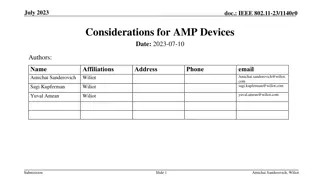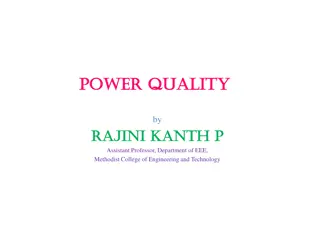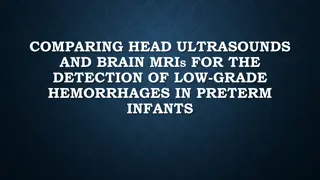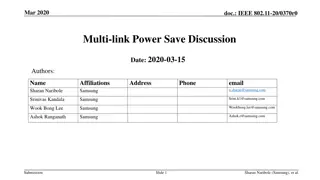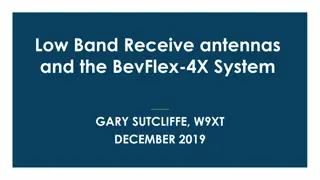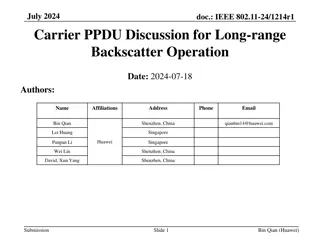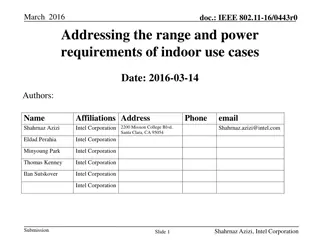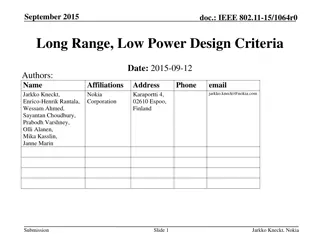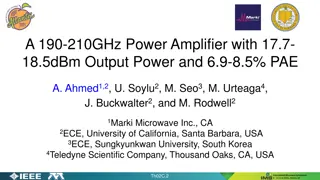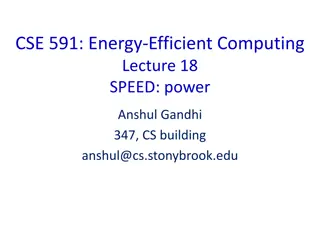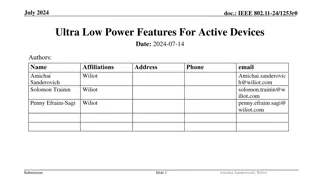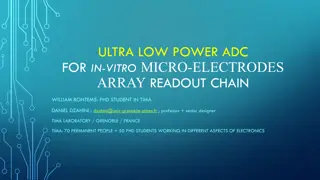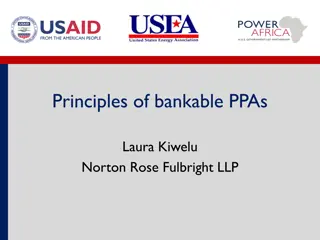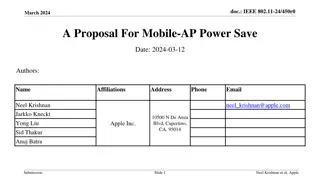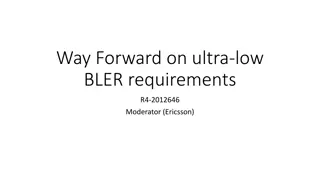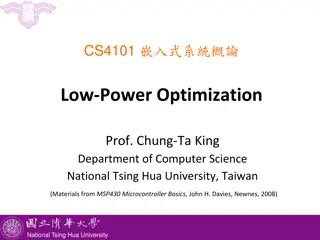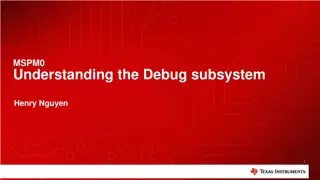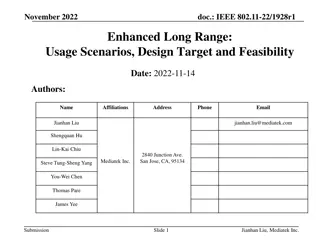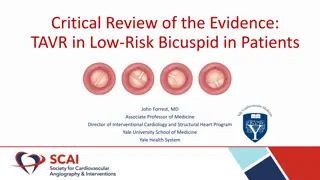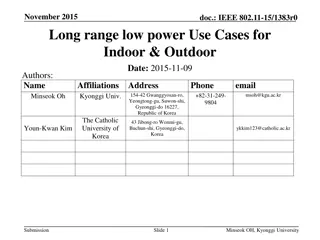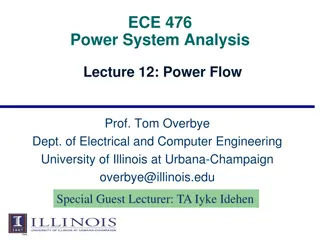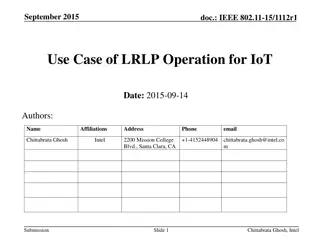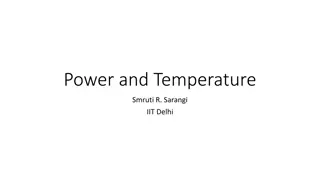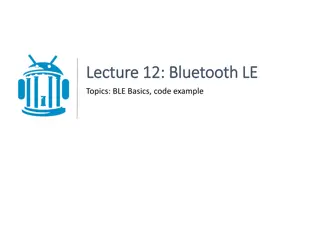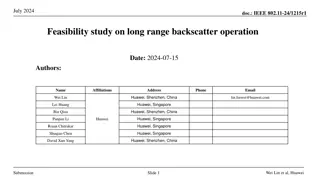Cisco Systems Fault Managed Power Portfolio Overview
Cisco Systems offers an industry-leading Fault Managed Power (FMP) patent portfolio comprising 24 active assets across seven INPADOC families. The portfolio includes patents supporting fault-managed power systems, PoE deployments, DC power distribution, DC-DC conversion, and HVDC connectors. The FMP
4 views • 4 slides
Improving Multi-Link Power Management Efficiency in IEEE 802.11 Networks
The document discusses challenges with per-link power mode changes in multi-link scenarios in IEEE 802.11 networks, proposing a solution for more efficient power management. It addresses issues such as latency and inefficiencies in signaling for power mode changes, introducing scheduled multi-link p
6 views • 9 slides
Long-Range Wireless Charging Market Report & Analysis _ BIS Research [2024-2035]
The Long-Range Wireless Charging Market has experienced robust expansion, fueled by the proliferation of smart devices and the increasing adoption of electric vehicles (EVs). According to recent studies, the global long-range wireless charging market is estimated to reach $3,279.6 million by 2035, a
1 views • 3 slides
Understanding Power Transfer and Impedance Matching in Circuits
Exploring the concept of maximizing power transfer between a source and load through impedance matching. Learn about complex conjugates, real and magnitude of complex numbers, average power in circuits, and the importance of minimizing reflected power. Discover how incident, reflected, and delivered
3 views • 33 slides
Overview of Farm Power Sources and Utilization in Agriculture
Farm power sources in agriculture include human, animal, mechanical, and renewable energy. Human power is costly but versatile, while animal power is traditional and provides manure. Mechanical power from tractors and engines is efficient. India's farm power sources reflect a mix of traditional and
0 views • 12 slides
Academic Senate Resolutions and Low-Cost Thresholds in Higher Education
The Academic Senate addresses the adoption of open educational resources (OER) and low-cost materials to support academic freedom and compliance with legislative requirements. The resolution discusses the definition of low-cost resources and the variability among California Community Colleges in set
2 views • 9 slides
Considerations for Ultra-Low Power AMP Devices in IEEE 802.11-23 Standard
This document discusses key considerations for designing ultra-low power and low-complexity energy harvesting based AMP-STAs within the IEEE 802.11-23 standard. It highlights limitations related to energy reserves, ambient power, and clock generation for active transmitters. The analysis emphasizes
0 views • 9 slides
Understanding Power Quality and Its Impact on Electrical Systems
Power quality refers to the characteristics of electrical power that drives sensitive equipment. It involves voltage and current deviations from ideal waveforms, impacting the efficiency and reliability of electrical systems. Various types of power quality phenomena exist, such as voltage variations
1 views • 16 slides
Detection of Low-Grade Hemorrhages in Preterm Infants: Ultrasounds vs. MRIs
This study compares the effectiveness of head ultrasounds and brain MRIs in detecting low-grade hemorrhages in preterm infants. It discusses the incidence of intraventricular hemorrhage (IVH) in very low birth weight infants, classification of IVH, risk factors for IVH, outcomes related to IVH grade
9 views • 33 slides
IEEE 802.11-20/0370r0 Multi-link Power Save Discussion
The document discusses multi-link power saving in the IEEE 802.11be standard. It reviews extreme low power multi-link operation modes, emphasizing the importance of enabling a single link for practical power savings. The proposed extreme low power mode introduces fixed and dynamic anchor links for e
0 views • 11 slides
Nuclear Physics Long Range Plans: Perspectives and Objectives
The need for a new long-range plan in nuclear physics, as outlined by Angela Bracco, emphasizes reassessment of current programs and the importance of advancing science in Europe. The objectives entail reviewing the field's status, issuing recommendations, and collaborating on a global scale to enha
0 views • 38 slides
Understanding Low Band Receive Antennas and the Beverage Flex-4X System
Low band receive antennas, including the Beverage Flex-4X system, are crucial for long-distance propagation on bands such as 160, 80, 60, and 40 meters. Operating on low bands presents challenges like large wavelengths, high levels of QRM and QRN, and the need for effective noise reduction strategie
1 views • 24 slides
Carrier PPDU Discussion for Long-range Backscatter Operation in IEEE 802.11-24
This document discusses the use of Carrier PPDU for long-range backscatter operation in IEEE 802.11-24 standard. It covers topics such as close-range and long-range backscatter in AMP, reader PPDU for close-range operation, and different topologies to support long-range backscatter. The content incl
0 views • 14 slides
Long Range Low Power IoT Applications for Indoor Environments
This document explores various IoT use cases for indoor environments, highlighting the importance of supporting IoT applications within the IEEE 802.11 community. The use cases include smart home devices like sensors, controllers, and appliances, emphasizing the need for low-power, high-speed wirele
0 views • 9 slides
IEEE 802.11-16/0443r0: Addressing Indoor Use Cases' Range and Power Requirements
This presentation by Shahrnaz Azizi from Intel Corporation discusses the range and power requirements of indoor use cases, focusing on the Smart Home as the most promising for successful 802.11 penetration into the IoT market. The presentation explores the need for low power and range in devices wit
2 views • 9 slides
IEEE 802.11-15/1064r0 Long Range, Low Power Design Criteria Study
Submission on design criteria for Long Range, Low Power (LRLP) in WLAN systems aiming to enhance transmission reliability and range while ensuring compatibility with existing WLAN networks. The key technical components include ultra-low power consumption, communication range extension, and coexisten
0 views • 8 slides
Learning-Based Low-Rank Approximations and Linear Sketches
Exploring learning-based low-rank approximations and linear sketches in matrices, including techniques like dimensionality reduction, regression, and streaming algorithms. Discusses the use of random matrices, sparse matrices, and the concept of low-rank approximation through singular value decompos
0 views • 13 slides
High-Efficiency Power Amplifier Design for 190-210GHz Range
Optimizing for high efficiency at OP1dB, this work presents a power amplifier operating in the 190-210GHz range with an output power of 17.7-18.5dBm and PAE of 6.9-8.5%. Utilizing a 250nm InP HBT process, the amplifier integrates four stages and demonstrates a gain of approximately 23dB. Key design
0 views • 26 slides
Exploring Power Efficiency in Computing Systems
In this lecture series on energy-efficient computing, various concepts related to dynamic frequency scaling, power capping, power shifting, power modeling, and power measurement are discussed. The impact of power on server speed is explored, alongside strategies for improving performance within powe
0 views • 17 slides
Comparison of Electricity Power Systems Between CEPC and FCCee
The evaluation and comparison of electricity power systems between the CEPC and FCCee accelerators reveal the power breakdowns, RF power consumption, magnet power supply, and overall power usage. Differences in power consumption for various components such as RF, magnets, and vacuum systems are high
0 views • 19 slides
Ultra Low Power Features for Active Devices in IEEE 802.11-24
This presentation discusses ultra low power features for active devices in IEEE 802.11-24, focusing on solutions for RF-harvesting AMP-only and AMP-assisted devices. It covers capabilities requirements, device solutions, and implementations such as constant envelope waveform, control and sensing cap
1 views • 14 slides
Insights into the Long-Term Care Market Trends
The long-term care marketplace presents a significant financial challenge for aging Americans, with over half of those turning 65 expected to require some form of long-term care. Despite misconceptions about the collapse of the private long-term care insurance market, millions of Americans are cover
0 views • 5 slides
Ultra Low Power ADC for In-Vitro Micro-Electrodes Array
Collaborative research project at TIMA Laboratory in France focusing on developing ultra-low power Analog to Digital Converters (ADC) for in-vitro micro-electrode arrays, aiming to enhance communication with the brain using electronics sensors. The project addresses key limitations such as power dis
0 views • 6 slides
Understanding Bankable Power Purchase Agreements in Independent Power Projects
Power Purchase Agreements (PPAs) play a crucial role in independent power projects, governing the sale and purchase of power between ProjectCo and the Offtaker. A bankable PPA is essential for a project to reach financial close, as it provides revenue for ProjectCo to repay funders and cover operati
0 views • 30 slides
Designing a Novel Low-Energy Beamline for NA61/SHINE at CERN
Carlo A. Mussolini from the University of Oxford, working at CERN, is designing a new low-energy beamline for NA61/SHINE experiment. The need for a low-energy beamline arises from the lack of particle production data in the 1-13 GeV/c momentum range. Current beam facilities at CERN face challenges w
0 views • 24 slides
Proposal for Mobile-AP Power Save in IEEE 802.11
This proposal by Neel Krishnan and team from Apple addresses the need to reduce power consumption in software-enabled access points (Mobile-APs). The focus is on prolonging battery life by minimizing power usage while ensuring full capabilities for associated STAs. The solution involves transitionin
0 views • 11 slides
Way Forward on Ultra-Low BLER Requirements in Wireless Communication
Explore the agreements and discussions around ultra-low BLER (Block Error Rate) requirements for URLLC (Ultra-Reliable Low Latency Communication) in wireless communication systems. Gain insights into the test methodologies, decision co-ordinates, applicability rules, and open issues related to CQI (
0 views • 9 slides
Advocating for the Rights of Low-Income Older Adults and LGBT Long-Term Care Consumers
The National Senior Citizens Law Center works tirelessly to protect the rights of low-income older adults through advocacy, litigation, and education. They advocate for LGBT long-term care consumers to ensure their health, economic security, and access to justice. A survey highlighted concerns faced
0 views • 18 slides
Low-Power Optimization in MSP430 Microcontroller at National Tsing Hua University
This material discusses the significance of low-power optimization in modern devices, focusing on the MSP430 microcontroller features for energy efficiency. It covers topics such as energy conservation, power generation, and strategies for reducing power consumption at the device, circuit, and syste
0 views • 23 slides
An Overview of MSPM0 Debug Subsystem
Understanding the MSPM0 Debug Subsystem by Henry Nguyen covering topics such as expected behaviors in low-power mode, SWD initialization sequence, modifying PWR-AP for low-power handling, utilizing RSTCTL bits, and more. The content includes details on proper sequences, behaviors in low-power states
1 views • 11 slides
Enhanced Long Range WiFi Solutions for IoT and Video Surveillance Applications
Outdoor IoT and certain indoor applications require enhanced long-range WiFi solutions for improved efficiency and compatibility. Features like relay using multi-AP can extend ranges but are not cost-effective. The booming home security camera market also necessitates enhanced long-range solutions t
0 views • 13 slides
Overview of Unified Power Flow Controller (UPFC) in Power Systems
A Unified Power Flow Controller (UPFC) is a combination of a Static Synchronous Compensator (STATCOM) and a Static Synchronous Series Compensator (SSSC) interconnected via a common DC link. UPFC allows bidirectional flow of real power and provides concurrent real and reactive series line compensatio
0 views • 20 slides
Understanding Leadership and Power Dynamics
Power and leadership are interconnected concepts, with power being the measure of a person's ability to influence others. Leaders have power in various situations, but it does not necessarily mean having power over people. Effective leaders balance their use of power with knowledge and trust, knowin
0 views • 9 slides
Critical Review of TAVR in Low-Risk Bicuspid Patients
TAVR has shown promising outcomes in tricuspid aortic stenosis but has not been extensively studied in low-risk bicuspid patients. The Low Risk Bicuspid Trial aims to evaluate the procedural and short-term outcomes of TAVR in this patient population through a prospective study involving 25 centers.
0 views • 21 slides
Long-Range Low Power IoT Use Cases for Indoor & Outdoor Environments
IoT applications in indoor and outdoor settings are explored in this document by Minseok Oh from Kyonggi University. The presentation discusses various IoT use cases, requirements, and characteristics for devices such as central controllers, sensors, appliances, and more. Specific use cases for home
0 views • 12 slides
Power System Analysis: Lecture on Power Flow
Lecture 12 on Power Flow Analysis in Power Systems covers the use of power balance equations when analyzing complex power consumption and generation. It explains the derivation of real power balance equations for iterative solutions in power flow analysis. The lecture highlights the need for iterati
0 views • 30 slides
IoT Use Case - Long Range Low Power Operation for Building Energy Management
This document outlines the use case of Long Range Low Power (LRLP) operation for Internet of Things (IoT), focusing on building energy management systems. It details how IoT-enabled HVAC systems in multi-storied homes can be remotely controlled to maintain optimal temperature, energy efficiency, and
0 views • 7 slides
Understanding Power Consumption and Temperature in Electronic Circuits
Explore the significance of power consumption in electronic circuits, focusing on reasons for high power, high temperature, and low reliability. Learn about sources of power consumption, types of power dissipation, dynamic power analysis, and the relationship between energy and power in circuits.
0 views • 30 slides
Introduction to Bluetooth Low Energy (BLE) Technology
Bluetooth Low Energy (BLE) is a wireless protocol that enables direct connections between devices such as phones and health trackers. It is a lightweight subset of classic Bluetooth, offering advantages like low power consumption and faster throughput. BLE devices typically have two roles: periphera
0 views • 19 slides
Feasibility Study on Long-Range Backscatter Operation for IEEE 802.11-24
This document from July 2024 discusses the feasibility of long-range backscatter operation for IEEE 802.11-24, focusing on close-range and long-range backscatters in mono-static and bi-static setups. It evaluates the link budgets, downlink link budgets, and the use cases for both operations, emphasi
0 views • 11 slides


![Long-Range Wireless Charging Market Report & Analysis _ BIS Research [2024-2035]](/thumb/87166/long-range-wireless-charging-market-report-analysis-bis-research-2024-2035.jpg)



